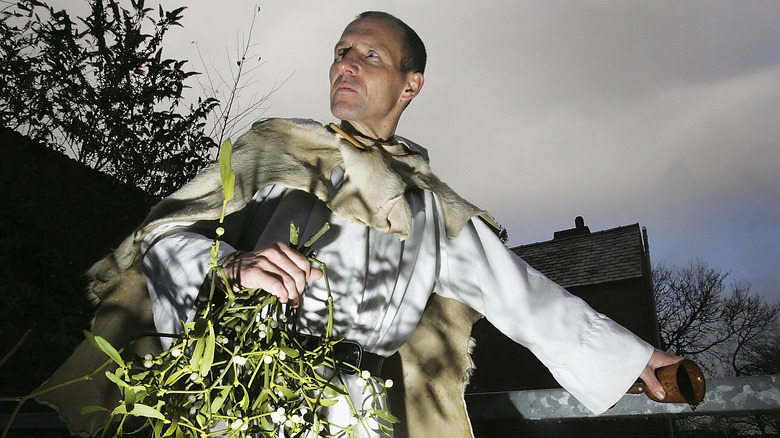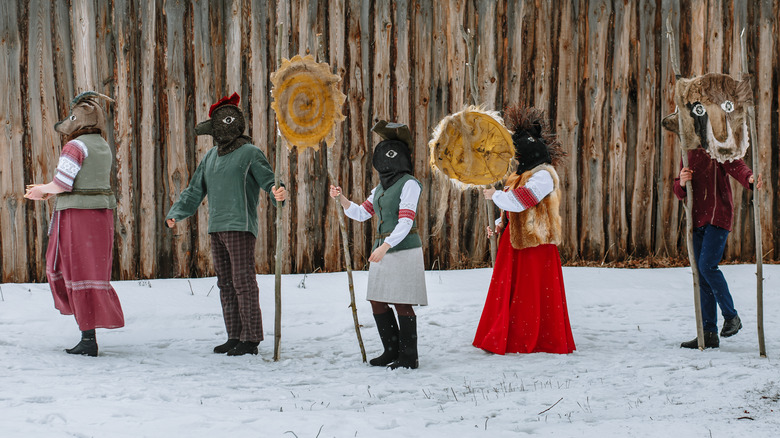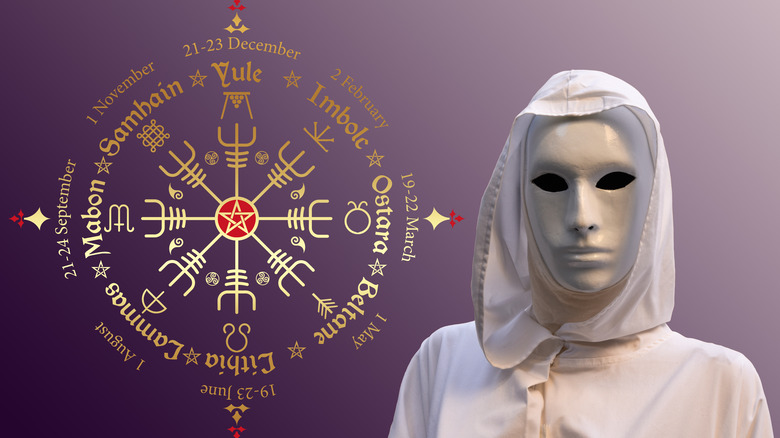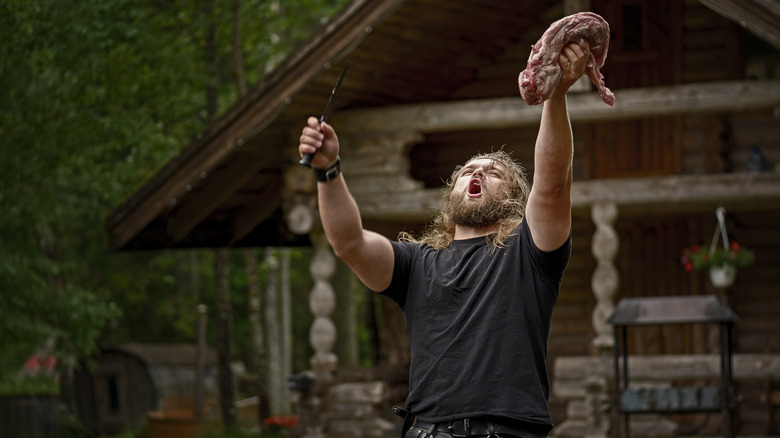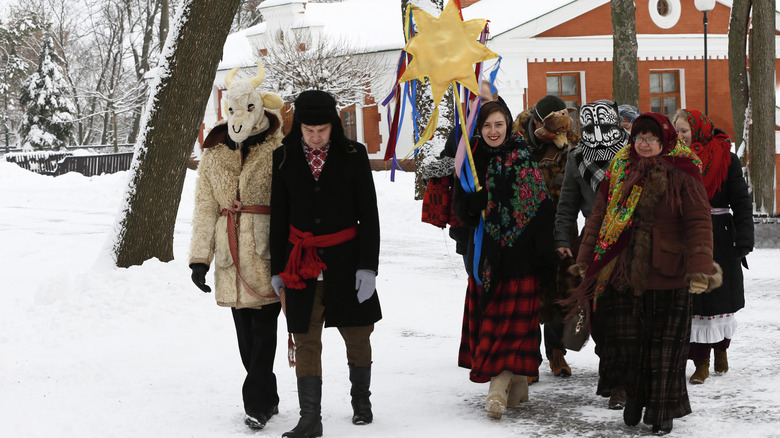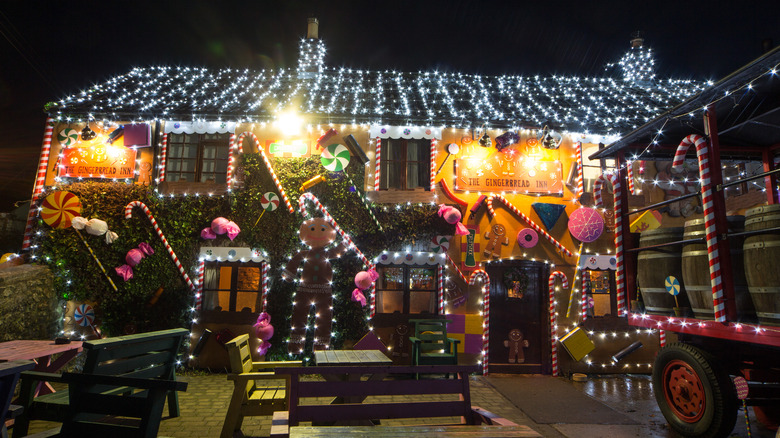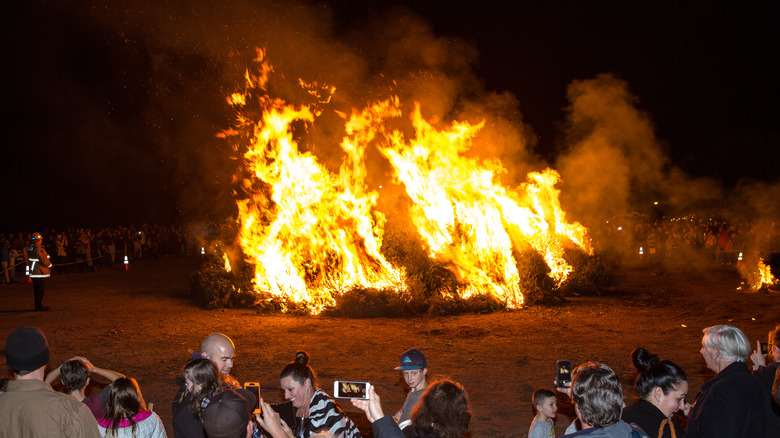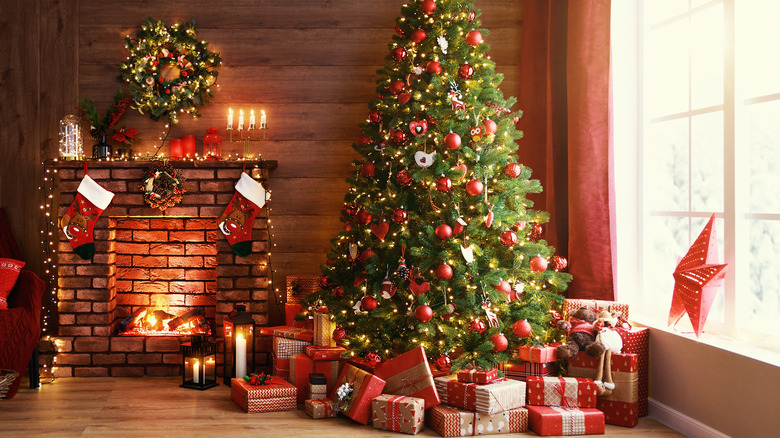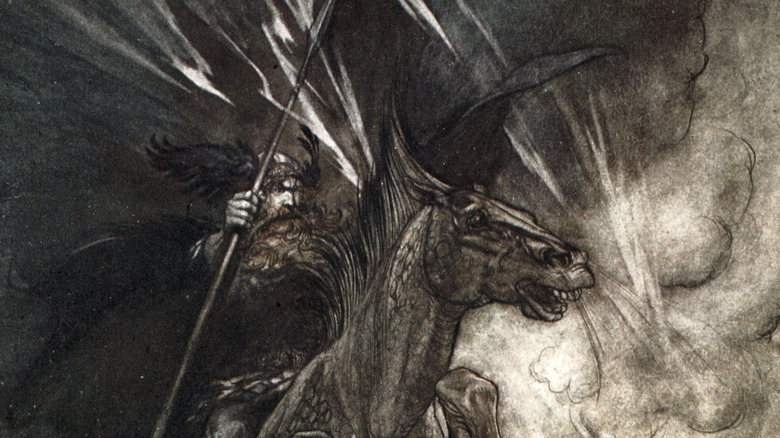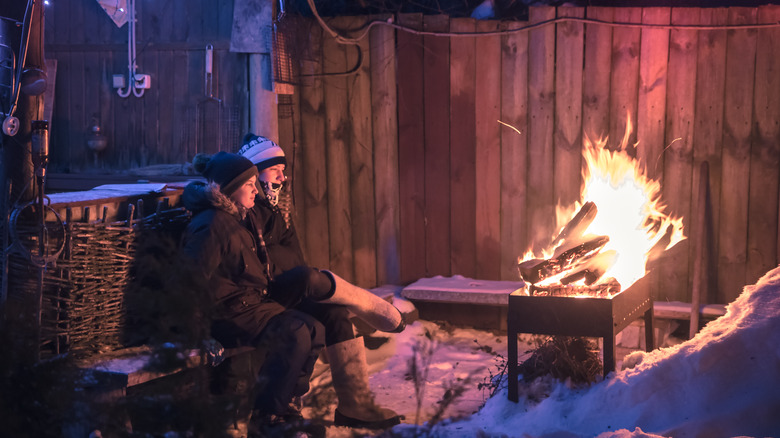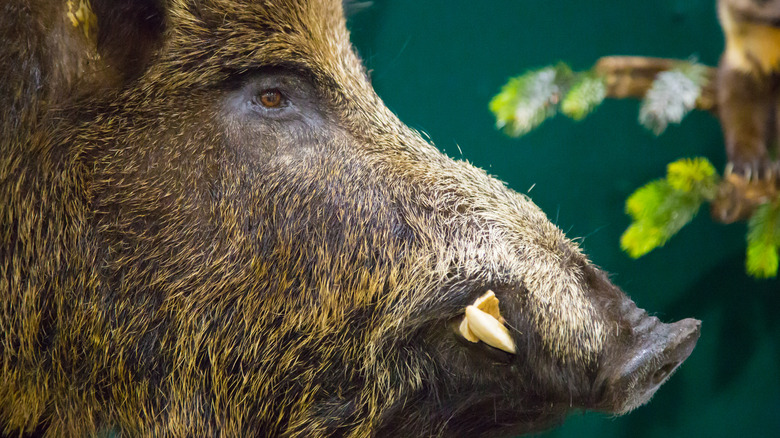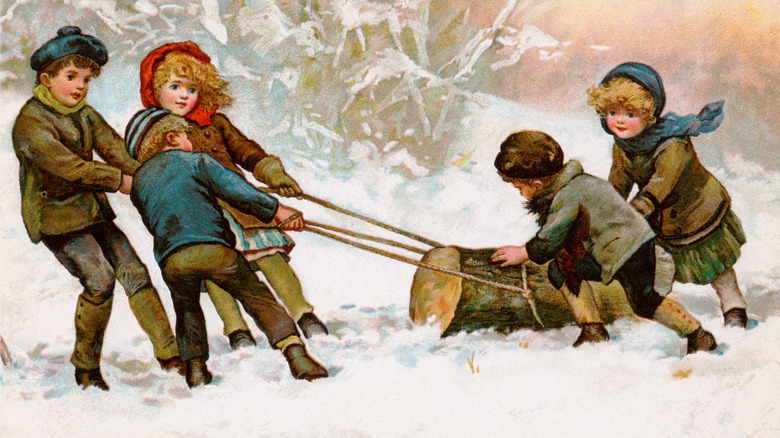What Is Yule And How Is It Celebrated?
When asked to describe Yule most people will likely say that it is another name for either Christmas, the holiday season as a whole, or a luscious holiday cake. This is true and untrue. Yule, as described by the BBC, was a holiday or festival that was celebrated by the polytheistic (i.e. pagan) peoples of Europe, particularly among the Germanic and Celtic people. But over the sweep of history many of the elements of Yule have been adopted, conflated with, and usurped by Christmas practices.
However, today there are modern pagans, called neopagans, who have revived Yule as one of their primary holidays. Neopagans are a diverse group and are hard to define. Generally, they are considered to be those who follow traditional folklore and polytheistic beliefs. Paganism has seen a revival since being stamped out by Christianity. Newsweek reported that between 1990 and 2018, the number of Wiccans, one sector of neopaganism, rose from 8,000 to 1.5 million. While neopagan beliefs are diverse — they are after all polytheistic — they all have an underlying devotion to nature, which is how they are connected to Yule.
This article will look at Yule and examine how it developed, how it was celebrated, and indeed, how people still celebrate it today.
Yule marks the winter solstice
The winter solstice, that day which marks the shortest amount of daylight in the year, has been a center of spiritual fascination since humans first gazed into the sky. Numerous traditions, which have been detailed by Britannica, such as the Soyal festival of the Hopi, the Roman Saturnalia, and the Dong Zhi of China, all celebrate the end of growing dark and the return of light.
Yule is the same as these holidays. It is a festival that marks the return of light. The holiday, as described in "Christmas Traditions Through the Prism of Paganism and Christianity" was first celebrated by the Scandinavians who then introduced it to the Celts and other peoples of northern Europe. These festivals were such a vital part of the culture of these people that many traditions of Yule (as well the Roman Saturnalia) were adopted as part of the way Christmas was celebrated.
Meanwhile, in recent years some have taken up the celebration of the old polytheistic Yule as neopagans. Yet not everybody's Yule is quite the same. Learn Religions notes that neopagans celebrate Yule in different ways, depending specifically on what kind of paganism you follow. For example, traditional Druid sites like Stonehenge have become important as part of the marking of solstice festivities.
Yule is a multi day holiday
"Christmas Traditions Through the Prism of Paganism and Christianity" tells us that Yule is a multi-day holiday. The origin of the term Yule is based on the calendar. This information comes to us from the medieval chronicler the Venerable Bede, who tells us that the Anglo-Saxons had called the months of December and January Giuli. Thus, as "Kings and Queens of Early Britain" explains, Yule was a two-month affair. This term is also cognate with geōl in Old English and jōl in Old Norse according to Merriam-Webster. It is from this that the term Yuletide comes.
This dating of Yule had to do with the way in which the Germanic pagans divided the year. "Modern Pagan Festivals" explains that there were several major seasonal festivals throughout the year called Sabbats (i.e. Sabbaths) which were based on the infinite cycle of seasons. Neopagans celebrate eight such festivals today of which Yule is the most prominent (along with Samhain, which is Halloween). Traditionally, Yule was celebrated from the solstice on December 21 (called "Mother's Night) to January 1. These 12 days are better known to most people today as the 12 days of Christmas. For neopagans, the most serious festivities occur at the beginning of Yule during the first three days. Mother's Night in particular, according to "The Divine Feminine in Ancient Europe," may have originated as a feast to acknowledge the Earth Mother and to ask for abundance in the coming year.
Modern Pagans can celebrate Yule twice a year
Traditional and modern pagans track their year on a calendar called by the World History Encyclopedia the Wheel of the Year. This calendar marks eight Sabbaths per year. Four marked by the solar calendar based on the solstices and equinoxes and four other festivals marked by the change of the seasons.
Of course, traditional paganism only occurred in the Northern hemisphere so determining the solstice was a straightforward astronomical exercise. However, modern pagans in the southern hemisphere face a winter solstice in July. The answer to the problem is clear. Pagans who live in the southern hemisphere in places like New Zealand, Australia, or Argentina simply light their Yule logs and set up their holiday trees six months out of step with those in the north. Some, like the author of "Yule" advises modern pagans to move or delay festivals based so as to "better fit your own locale."
Historical Yules featured animal sacrifices
Traditional celebrations of Yule featured important animal sacrifices, called Blót, as noted in ""The Viking Age." These were held at the end of Yule, typically involved a goat, and were dedicated to the god Thor. "Yule" adds that boar was also an important sacrificial animal. In some ways, this has been revived by neopagan groups such as modern Asatru who worship traditional Norse gods and who have developed guides, such as "Llewellyn's Sabbats Almanac" to provide some context and guidance. Since goat was one of the main sacrificial victims, it is from goat that a variety of traditions have arisen, including dressing in goat skins or crafting a straw Yule goat. It is recommended that goat be served for the Yule feast as well.
Animal sacrifice nowadays is rare. Most celebrations of Yule, as reported by the Lansing City Pulse, are more innocuous in nature with groups treating the solstice event as the new year while doing charitable work like many other religious groups do. However, there have been efforts to revive animal sacrifice, according to "Putting the Blood back into Blót." This has naturally enough led to outrage from various sectors of society including other religious practitioners and animal rights activists.
Yule was synchronized with Christmas in the 10th century
Yule carried on as a purely polytheistic happening until the reign of King Haakon the Good of Norway. This Norse king, who reigned from approximately 933 to 960 C.E., according to Britannica, had been raised as a Christian in England and when he came to Norway he introduced missionaries to try to convert the Norse. As part of these efforts, he rescheduled Yule to coincide with Christmas (according to "North: How to Live Scandinavian") which ended up extending the Yule holiday. He helped turn pagan minds onto the idea by encouraging drinking during Yule and according to "Christmas: A Short History from Solstice to Santa" even levied fines on those who did not drink ale during Yule.
While Haakon's efforts to Christianize his subjects largely failed because of pushback from the Norse chieftains under him, he nevertheless began the process that conflated Yule traditions with Christmas. He also managed to insert the first extension of the Christmas season. It is unclear if Haakon allowed for longer shopping hours.
Yule involves lots of lights
The nature of the winter solstice makes it essentially a festival of light. Yule has a number of traditions which emphasize this aspect of it. Learn Religions notes this emphasis on light, urging practitioners to liberally use candles, lights, and bonfires to mark the occasion.
One tradition that is shared between neopagans and Christians is the use of the Yule log. The Yule log was a large log that was set on fire throughout Yule. According to the World History Encyclopedia, a piece of the log was usually kept after Yule in order to begin the fire of next year's Yule. These were often dragged into the village or house with great ceremony, often being highly decorated. They were also converted into delicious cakes. Also important were bonfires which carried on the celebration of light.
This is confirmed by one contemporary pagan who was interviewed by KWQC: "It is the day that the sun is reborn ... we have a little sun baby underneath our tree so on Monday when we finish our solstice ritual we take him out. So you can kind of see the parallels to Christianity so it's very much the same kind of idea. So we celebrate the light. So we honor the dark, but we also honor the light coming back, the sun being reborn, and the hope that there will be a spring."
Yule venerates trees
In much the same way that Yule celebrates a return of light, it also celebrates a return of life. The U.S. Forest Service explains that traditionally trees were considered sacred. In particular, the holly was seen as a sign of the dwindling light of winter while the oak was seen as symbolic of the return of the sun. Holly, which is frequently used in wreaths and other holiday ornaments was viewed as being evergreen as a divine way to keep the land beautiful even while all other greenery faded in the face of winter. Decking doors with boughs of holly started as an Irish tradition, meant to grant luck in the coming year.
Likewise, the mistletoe, while not a tree but a parasitic evergreen plant, was seen as a sacred plant in many of the polytheistic cultures of ancient Europe. In fact, the use of greenery and evergreens in solstice events is a common thread among traditional polytheistic faiths. However, the custom of being obliged to kiss under the mistletoe belongs to the Norse. These types of decorations are also kept by those who practice the pagan version of Yule.
The Yule Tree and Christmas Tree are indistinguishable
The most noticeable Yule decoration is the Yule Tree or solstice tree which is the Christmas tree. The Christmas tree custom remained rooted in Germany after its Christianization and passed on to other nations only in the 19th century, according to the U.S. Forest Service. The Christmas tree was slow to be adopted, since as explained by History, many Christian sects saw it as a pagan symbol — which it certainly had been. For example, New England Puritans would not allow any kind of Christmas décor, believing the holiday to be purely sacred and not a time for ostentation.
"Llewellyn's Sabbat Almanac" advises modern pagans that decorating with a solstice tree is appropriate since the "tree is a symbol of the sacred groves of Pagan traditions that venerated deities believed to reside in trees." What is more, pagans hung items such as ribbons and charms from the tree to supplicate the deity for assistance. Thus, it is not a far step in logic to see why gifts should be left under the Yule tree. The only difference it seems between a Christmas tree and a Yule tree is the choice of ornaments, which may differ greatly.
Yule's Odin is really Santa Claus
One often asked question is: what is the historic origin of Santa Claus? There are several theories offered by "The Mythology of America's Seasonal Holidays," with one being that the figure of the Norse god Odin, with accoutrements from Thor, was the original Santa Claus. It was said that during the yuletide Odin visited people's homes by riding through the sky on his eight-legged horse Sleipnir. Note that Odin is usually depicted as an old man with a white beard and that modern Santa has eight reindeer to Sleipnir's eight legs. This, however, is highly speculative and unproven. It is true, however, that children believed until the 1800s that Thor's two goats, Tanngrisnir and Tanngnjóstr, delivered their presents. Odin, in fact, may be the original Father Christmas since one of his many names was, as told in "About Christmas," Jolnir, which refers to the Old Norse word for Jol, the Yule holiday. What seals the deal is that Odin was also known to lead the so-called "Wild Hunt" through the skies at this time of year.
How do modern pagans view Santa Claus? According to Mel Magazine the answer is obvious: Santa is a "textbook magical creature" that performs miracles.
Yule is a time for storytelling
Yule was in the dead of winter. People were confined indoors, so it is not surprising to learn that storytelling became a common tradition around the Yule log, which has been adopted by modern pagans. One book, "The Sabbats," relates how in Ireland, it became customary at Yule to tell stories from Irish mythology, particularly of the god Finn MacCool, who protected Ireland from invaders.
As for modern pagans, some incorporate these storytelling elements into their celebration of Yule. Another twist on this is to engage in pathworking, which is a form of guided meditation that is meant to impart wisdom and change upon the spirit. Much like spirit quests, it puts participants through storytelling into some of the archetypal myths of pagan belief.
The tradition of storytelling has also been incorporated into Christmas traditions such as Dickens' "A Christmas Carol." "The Book of Altars and Sacred Spaces" points out that sadly much of this tradition is lost to both modern pagans and Christians due to technologies that have eroded at storytelling.
Yule's main feast involves a boar's head
All Yules demand a feast, and the traditional centerpiece among traditional pagan practice was a boar's head. According to "American Cookery" the custom of holding forth over a boar's head was common until the medieval period. It is from this that many an inn and possibly a packaged deli meat company got its name. Yet from a spiritual point of view the boar was a sacred animal. "Muelos: A Stone Age Superstition about Sexuality" tells us that the boar was sacred to the Norse fertility goddess Freyr. It was also the centerpiece of an everlasting feast in Odin's hall in Valhalla.
This is not to say that modern pagans regularly bust out a boar's head at the Yuletide table. Learn Religions suggests recipes ranging from plum pudding to "Savory Plum King Soup" to a good old traditional chocolate Yule log. One other suggestion is the hot drink wassail, a concoction of nutmeg, ginger, cinnamon, apple cider, and other ingredients, plus a good dose of brandy if you are so inclined. Curiously, the name of this drink comes from the pagan custom of wassailing in which revelers would go singing in the fields to drive out any evil spirits that might prevent a bountiful crop when spring came. By the 19th century, this custom had evolved to caroling.
Yule is celebrated in different ways
If it is not clear by now, since modern polytheists believe in many divine forces, there is naturally a diversity of ceremonies surrounding how Yule is carried out. As Learning Religions indicates, if you are a modern pagan, how you practice Yule will depend on how your local group practices. Aside from the differences due to the natural tendency for polytheistic beliefs to encourage diversity, Yule has become localized since there has not really been any strong central authority. That is to say that no modern pagan religion has the hierarchy approaching that of a traditional institution such as the Roman Catholic Church. This is no doubt because such practices were socially reprehensible to the monotheistic community at large, as well as just illegal.
However, for Yule, there does seem to be some different types of standard practices which fall onto how Sabbaths are practiced. These, described in "The Encyclopedia of Modern Witchcraft and Neo-Paganism" may include establishing an altar, evoking the gods for a congregation, acting out mystery plays to explain the significance of the festival, as well as specifically honoring a divinity like the Holly King. The Lansing City Pulse, reports that one congregation of Wiccans reflected on the past year and expressed their hopes for the coming year. In other words, the holiday is celebrated how people everywhere around the world celebrate end of year holidays.
